Overview
The Application Centric Infrastructure (ACI) Fabric hardware includes an Application Policy Infrastructure Controller (APIC) appliance (a cluster of three controllers), one or more leaf switches, and one or more spine switches for each leaf switch (for switch compatibility, please see the Cisco Nexus 9000 Series Switches data sheets). The following figure shows how these components are interconnected to form the ACI Fabric.

This hardware installation guide explains how to set up the ACI fabric by connecting installed APIC controllers, leaf switches, and spine switches. For information on installing each of these components in racks, see the installation guide for that device.
For information about creating the initial switch configuration for the switches in the ACI fabric, see the Cisco APIC Getting Started Guide, which also explains how to connect the optional console, out-of-band, and in-band management interfaces, which you can use for monitoring and troubleshooting.
Cisco APIC Appliance Connection Features
The Cisco APIC appliance has two form factors for medium or large configurations. Medium configurations have medium-size CPU, hard drive, and memory for up to 1000 edge ports. Large configurations have large-size CPU, hard drive, and memory for more than 1000 edge ports.
 Note |
For rack installation instructions using the UCSC-RAIKB-M4= Rail Kit, see the Installing the Server section of the Cisco APIC M3/L3 Server Installation and Service Guide. |
An APIC appliance comprises either a cluster of Cisco APIC M3/L3 (third generation appliance), Cisco UCS 220 M4 (second generation appliance) or Cisco UCS 220 M3 (first generation appliance) servers manufactured with an image secured with Trusted Platform Module (TPM), certificates, and an APIC product ID (PID). To order these appliance clusters (and additional controllers), you must use the part numbers listed in the following table.
|
Appliance Generation |
Cisco APIC Configuration |
Part Number |
Description |
|---|---|---|---|
|
Third |
Large cluster |
APIC-CLUSTER-L3 |
Cluster of three Cisco APIC third generation controllers with large size CPU, hard drive, and memory configurations for more than 1200 edge ports. |
|
Medium cluster |
APIC-CLUSTER-M3 |
Cluster of three Cisco APIC third generation controllers with medium size CPU, hard drive, and memory configurations for up to 1200 edge ports. |
|
|
Large controller (spare) |
APIC-L3 |
Third generation Cisco APIC with large CPU, hard drive, and memory. |
|
|
Medium controller (spare) |
APIC-M3 |
Third generation Cisco APIC with medium CPU, hard drive, and memory. |
|
|
Second |
Large cluster |
APIC-CLUSTER-L2 |
Cluster of three Cisco APIC second generation controllers with large size CPU, hard drive, and memory configurations for more than 1000 edge ports. |
|
Medium cluster |
APIC-CLUSTER-M2 |
Cluster of three Cisco APIC second generation controllers with medium size CPU, hard drive, and memory configurations for up to 1000 edge ports. |
|
|
Large controller (spare) |
APIC-L2 |
Second generation Cisco APIC with large CPU, hard drive, and memory. |
|
|
Medium controller (spare) |
APIC-M2 |
Second generation Cisco APIC with medium CPU, hard drive, and memory. |
|
|
First |
Large cluster |
APIC-CLUSTER-L1 |
Cluster of three Cisco APIC first generation controllers with large size CPU, hard drive, and memory configurations for more than 1000 edge ports. |
|
Medium cluster |
APIC-CLUSTER-M1 |
Cluster of three Cisco APIC first generation controllers with medium size CPU, hard drive, and memory configurations for up to 1000 edge ports. |
|
|
Large controller (spare) |
APIC-L1 |
First generation Cisco APIC with large CPU, hard drive, and memory. |
|
|
Medium controller (spare) |
APIC-M1 |
First generation Cisco APIC with medium CPU, hard drive, and memory. |
The following figure identifies the ports and connectors that you use when connecting a third-generation APIC controller to the ACI Fabric.

|
1 |
USB 3.0 ports (two) |
6 |
Rear unit identification button/LED |
|
2 |
Dual 1-Gb/10-Gb Ethernet ports (LAN1 and LAN2) The dual LAN ports can support 1 Gbps and 10 Gbps, depending on the link partner capability. |
7 |
Power supplies (two, redundant as 1+1) |
|
3 |
VGA video port (DB-15 connector) |
8 |
PCIe riser 1/slot 1 (x16 lane) |
|
4 |
1-Gb Ethernet dedicated management port |
9 |
VIC 1455 with external 10/25-Gigabit Ethernet ports (4) |
|
5 |
Serial port (RJ-45 connector) |
10 |
Threaded holes for dual-hole grounding lug |
 Note |
VIC 1455 supports 10/25-Gigabit with the following restrictions:
|

|
1 |
Virtual Interface Card (VIC) for either optical (VIC1225) connections or 10GBASE-T (VIC1225T) connections |
4 |
Management port (RJ-45) for a direct connection to a console (you can use the console port on either side of the device) |
|
2 |
Two fiber optic or 10GBASE-T ports for connections to a downlink port on one or two TOR switches |
5 |
Out-of-band management ports for management of APIC OS only (cannot be used to access the CIMC management interface; APIC's only support the dedicated NIC mode in CIMC) |
|
3 |
Cisco Integrated Management Controller (CIMC) port dedicated to a console (1-Gigabit Ethernet connection) connection |
The following figure identifies the ports and connectors that you use when connecting a first-generation APIC controller to the ACI Fabric.

|
1 |
Virtual Interface Card (VIC) for either optical (VIC1225) connections or 10GBASE-T (VIC1225T) connections |
4 |
Cisco Integrated Management Controller (CIMC) port dedicated to a console (1-Gigabit Ethernet) connection |
|
2 |
Two fiber optic or 10GBASE-T ports for connections to a downlink port on one or two TOR switches |
5 |
Out-of-band management ports for management of APIC OS only (cannot be used to access the CIMC management interface; APIC's only support the dedicated NIC mode in CIMC) |
|
3 |
Management port (RJ-45) for a direct connection to a console (you can use the console port on either side of the device) |
Cisco Leaf Switch Connection Features
This section identifies the connection features that you use when connecting the following leaf switches to the Cisco ACI Fabric:
-
Cisco Nexus 93128TX ACI-mode switch
-
Cisco Nexus 9332PQ ACI-mode switch
-
Cisco Nexus 9372PX ACI-mode switch
-
Cisco Nexus 9372PX-E ACI-mode switch
-
Cisco Nexus 9372TX ACI-mode switch
-
Cisco Nexus 9396PX ACI-mode switch
-
Cisco Nexus 9396TX ACI-mode switch
The following figure identifies port features on the Cisco Nexus 93128TX ACI-mode switch.
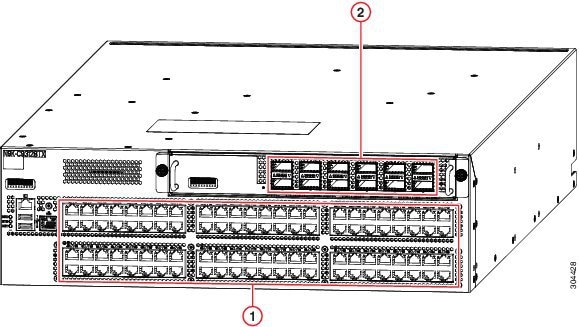
|
1 |
10GBASE-T, APIC-facing, SFP+ interface ports (48) (supporting 100-Megabit, 1-Gigabit, and 10-Gigabit speeds) |
2 |
4 100-Gigibit or 6 40-Gigabit, or 12 40-Gigabit, spine-facing QSFP+ optical ports (12-port uplink module shown)
|
For other features on this switch, see the Cisco Nexus 93128TX ACI-Mode Switch Hardware Installation Guide.
The following figure identifies port features on the Cisco Nexus 9332PQ ACI-mode switch.
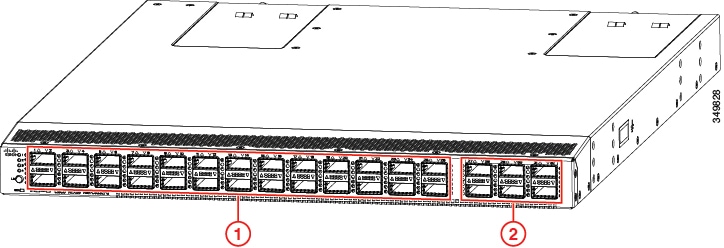
|
1 |
40-Gigabit, APIC-facing, QSFP+ interface ports (26). Ports 1 to 12 and 15 to 26 also support 40-Gigabit-to-4x10-Gigabit breakout cables with the Dynamic Breakout feature. |
2 |
40-Gigabit, spine-facing, QSFP+ interface ports (6) |
For other features on this switch, see the Cisco Nexus 9332PQ ACI-Mode Switch Hardware Installation Guide.
The following figure identifies port features on the Cisco Nexus 9372PX and 9372PX-E ACI-mode switch.
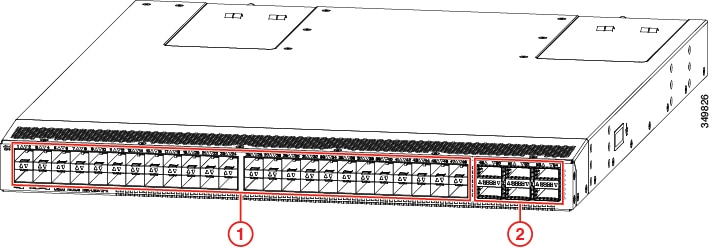
|
1 |
1- and 10-Gigabit, APIC-facing, SFP+ interface ports (48) |
2 |
40-Gigabit, spine-facing, QSFP+ interface ports (6) |
For other features on this switch, see the Cisco Nexus 9372PX and 9372PX-E ACI-Mode Switch Hardware Installation Guide.
The following figure identifies port features on the Cisco Nexus 9372TX ACI-mode switch.
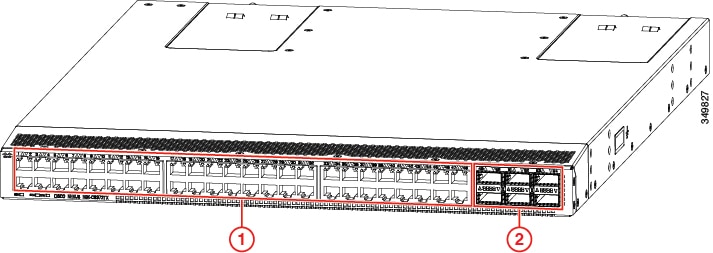
|
1 |
10GBASE-T, APIC-facing, SFP+ interface ports (48) (supporting 100-Megabit, 1-Gigabit, and 10-Gigabit speeds) |
2 |
40-Gigabit, spine-facing QSFP+ interface ports (6) |
For other features on this switch, see the Cisco Nexus 9372TX ACI-Mode Switch Hardware Installation Guide.
The following figure identifies port features on the Cisco Nexus 9396PX ACI-mode switch.
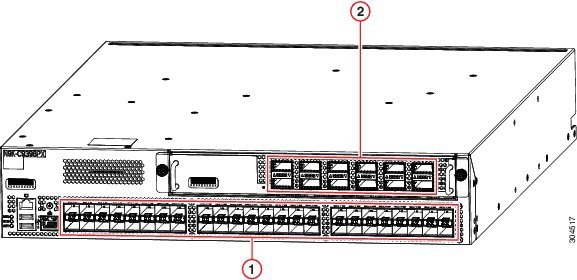
|
1 |
10-Gigabit, APIC-facing, SFP+ interface ports (48) |
2 |
4 100-Gigibit or 6 40-Gigabit, or 12 40-Gigabit, spine-facing QSFP+ optical ports (12-port uplink module shown) |
For other features on this switch, see the Cisco Nexus 9396PX ACI-Mode Switch Hardware Installation Guide .
The following figure identifies port features on the Cisco Nexus 9396TX ACI-mode switch.
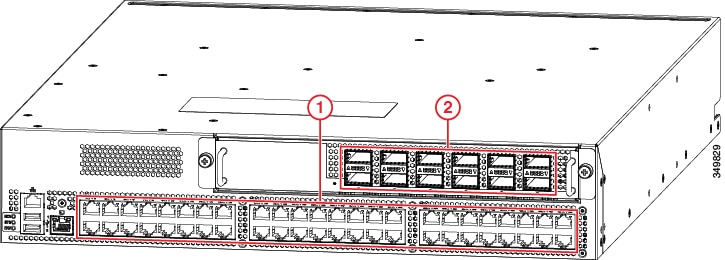
|
1 |
10GBASE-T, APIC-facing, SFP+ interface ports (48) (supporting 100-Megabit, 1-Gigabit, and 10-Gigabit speeds) |
2 |
4 100-Gigibit or 6 40-Gigabit, or 12 40-Gigabit, spine-facing QSFP+ optical ports (12-port uplink module shown) |
For other features on this switch, see the Cisco Nexus 9396TX ACI-Mode Switch Hardware Installation Guide.
Cisco Spine Switch Connection Features
This section identifies the connection features that you use when connecting the following spine switches to the Cisco ACI Fabric:
-
Cisco Nexus 9336PQ ACI-mode switch
-
Cisco Nexus 9504 ACI-mode switch
-
Cisco Nexus 9508 ACI-mode switch
-
Cisco Nexus 9516 ACI-mode switch
The following figure identifies port features on the Cisco Nexus 9336PQ ACI-mode switch.
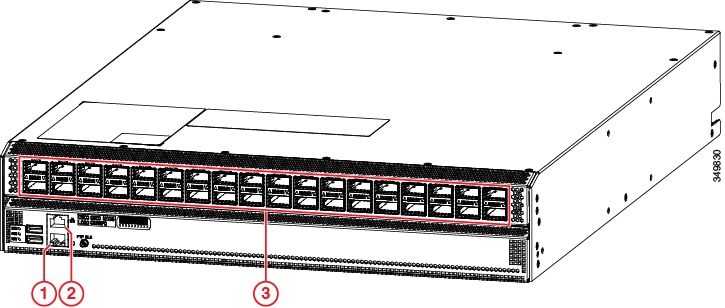
|
1 |
Out-of-band management port |
3 |
40-Gigabit QSFP+ ports (36) |
|
2 |
Console port |
The following figure identifies the features that you use when installing the Cisco Nexus 9504 switch with the Cisco ACI Fabric hardware.
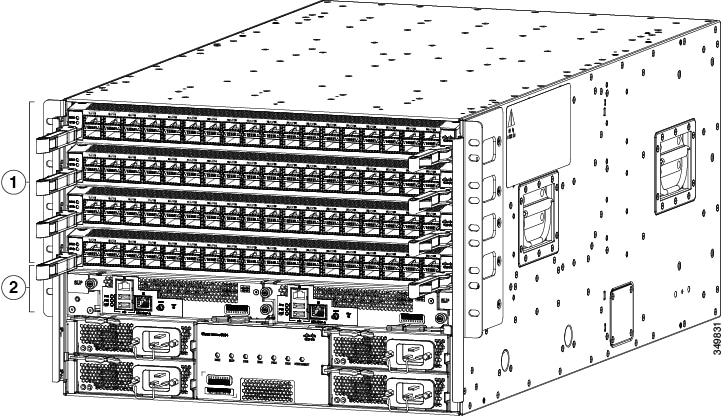
|
1 |
Line cards (such as the N9K-X9736PQ line card) in slots LC 1 to LC 4 |
2 |
Supervisor modules (one or two) in slots SUP 1 and SUP 2 with console and management ports |
The following figure identifies the features that you use when installing the Cisco Nexus 9508 switch with the Cisco ACI Fabric hardware.
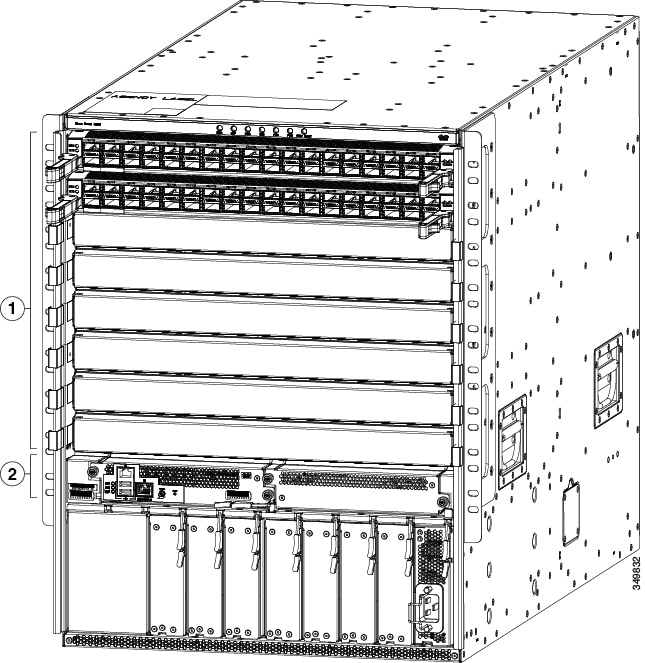
|
1 |
36-port 40-Gigabit line cards (such as the N9K-X9736PQ line card) in slots 1 to 8 |
2 |
Supervisor modules (one or two) in slots 27 and 28 with console and management ports |
The following figure identifies the features that you use when installing the Cisco Nexus 9516 switch with the Cisco ACI Fabric hardware.
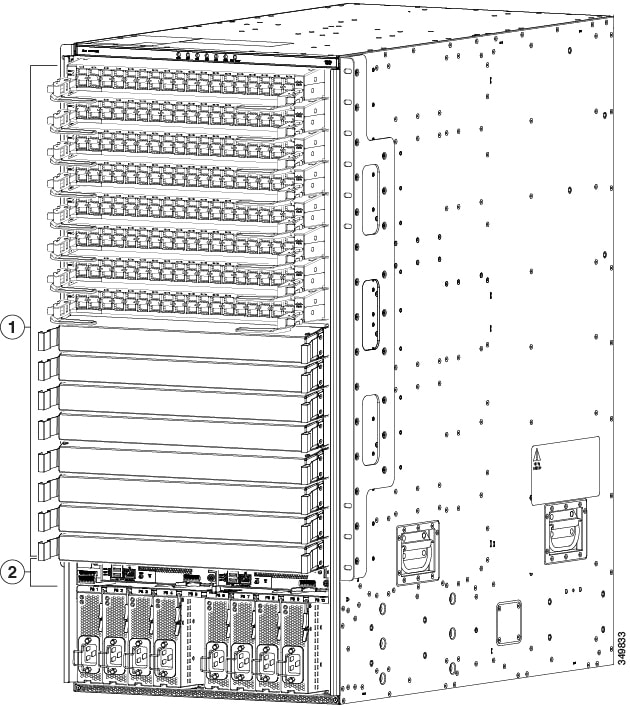
|
1 |
36-port 40-Gigabit line card (such as the N9K-X9736PQ line card) in slots 1 to 16 |
2 |
Supervisor modules (one or two) in slots 27 and 28 with console and management ports |
For information about installing these switches in racks, see the following documents:
-
Cisco Nexus 9336PQ Switch Hardware Installation Guide
-
Cisco Nexus 9504 ACI-Mode Switch Hardware Installation Guide
-
Cisco Nexus 9508 ACI-Mode Switch Hardware Installation Guide
-
Cisco Nexus 9516 ACI-Mode Switch Hardware Installation Guide
 Feedback
Feedback